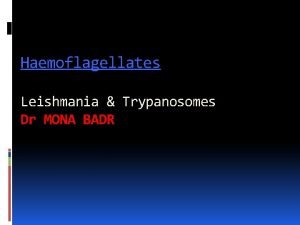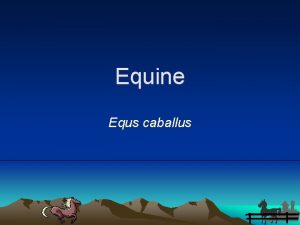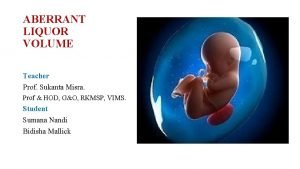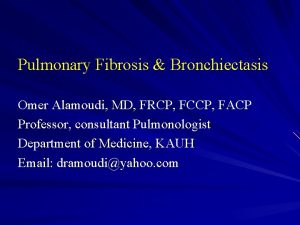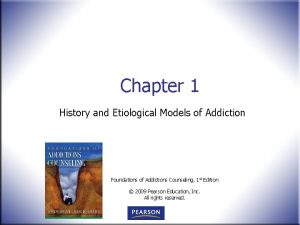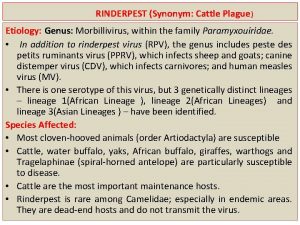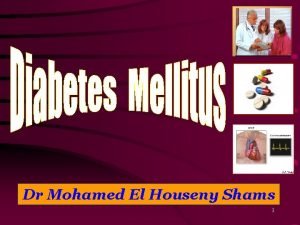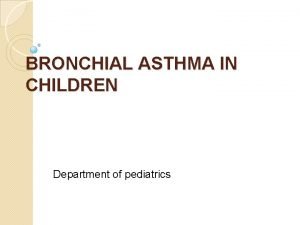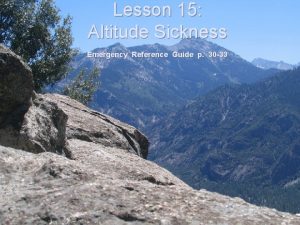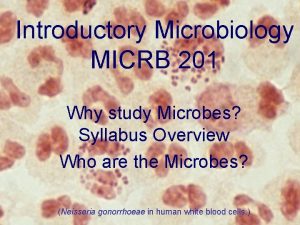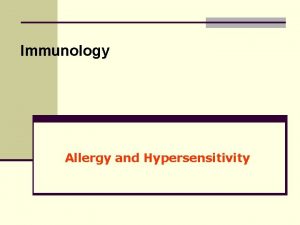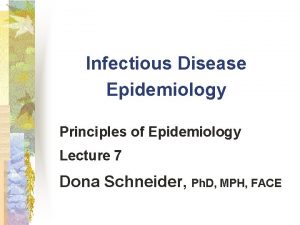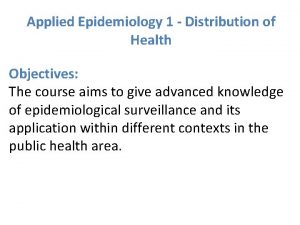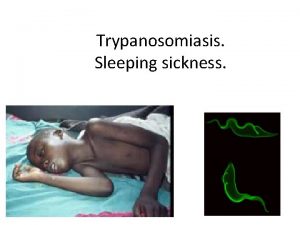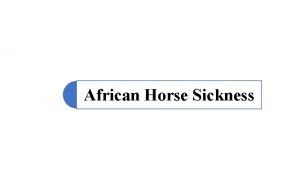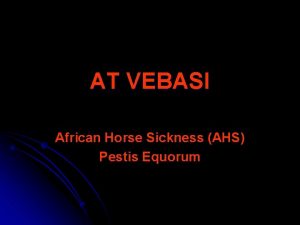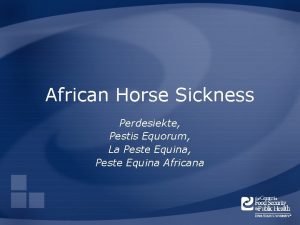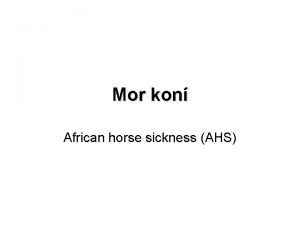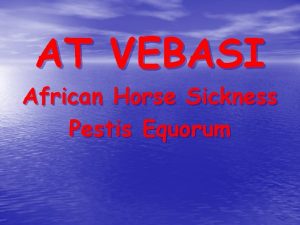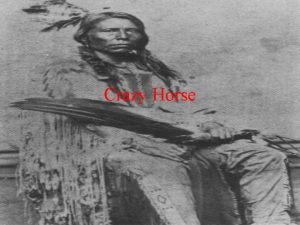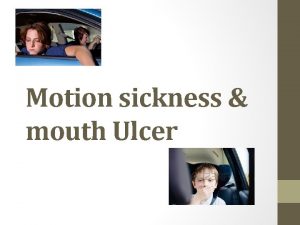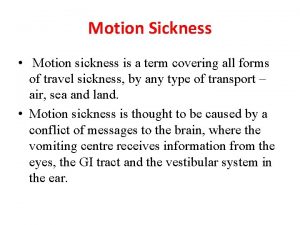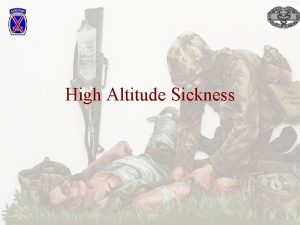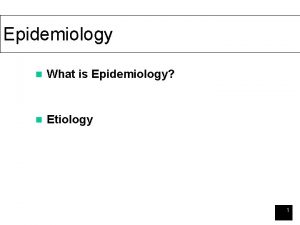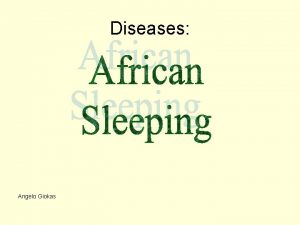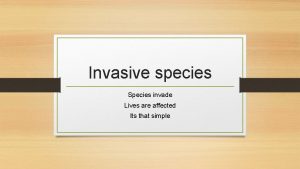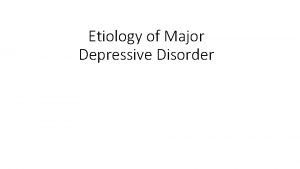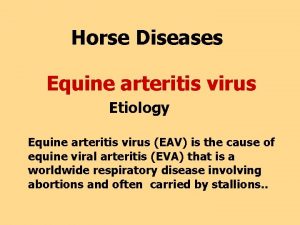African Horse Sickness OVERVIEW Etiology Species Affected Epidemiology









































- Slides: 41

African Horse Sickness

OVERVIEW Etiology Species Affected Epidemiology Economic Importance Clinical Signs Diagnosis and Treatment Prevention and Control Actions to Take

ETIOLOGY

AFRICAN HORSE SICKNESS VIRUS Non-enveloped RNA Family Reoviridae Genus Orbivirus Nine serotypes (1 -9) All viscerotropic Serotype 9 Endemic areas Outbreaks outside of Africa Serotypes 1 -8 Limited geographical areas

AFRICAN HORSE SICKNESS VIRUS Inactivated by Heat (temps greater than 140 o. F) p. H less than 6, or 12 or greater Acidic disinfectants Rapidly destroyed in carcasses that have undergone rigor mortis

EPIDEMIOLOGY

SPECIES AFFECTED Equidae Horses, donkeys, mules Zebras Other Camels Dogs

GEOGRAPHIC DISTRIBUTION Endemic in sub-Saharan Africa Outbreaks Southern and northern Africa Near and Middle East Spain and Portugal

OIE DISEASE DISTRIBUTION MAP

INCIDENCE/PREVALENCE Seasonal Late summer - early autumn Cyclic Drought followed by heavy rains Influences insect breeding Epizootics halted by Frost Lack of long-term vertebrate reservoir Reduced numbers of vectors Control measures Vaccination, vector abatement

MORBIDITY/MORTALITY Varies with species, previous immunity, form of disease Mortality based on species Horse particularly susceptible Species Mortality Horses 50 -95% Mules 50% European and Asian donkeys 5 -10% African donkeys and zebras Rare

MORBIDITY/MORTALITY Mortality based on form of disease Disease Form Mortality Pulmonary form Up to 95% Cardiac form 50% or more Mixed form 70 -80% Horsesickness fever Typically recover

TRANSMISSION

TRANSMISSION Not contagious Vector-borne: Culicoides spp. Culicoides imicola – principal vector C. bolitinos C. variipennis Other potential arthropods Viremia in Equidae Horses: 12 to 40 days Zebras, African donkeys: up to 6 weeks

CULICOIDES SPP. Biting midges, “punkies”, “no-see-ums” Extremely small ~1/8” Species identified by wing pattern Habitat Margins of water sources Life cycle: 2 -6 weeks Eggs hatch in 2 -10 days Females are bloodsucking Greatest biting activity dusk to dawn

ECONOMIC IMPORTANCE

U. S. ECONOMIC IMPACT U. S. Horse Industry (2007) Inventory: 4 million horses Sales: $2. 0 billion Employment: 4. 6 million Americans Risk factors Disease not in U. S. – naïve population Arthropod vector is in U. S. Outbreak would result in movement and trade restrictions

AFRICAN HORSE SICKNESS IN ANIMALS

INCUBATION PERIOD Experimental: 2 -21 days Natural infection: 3 -14 days Disease Form Incubation Period Peracute (pulmonary) form 3 -5 days Subacute (edematous or cardiac) form 7 -14 days Acute (mixed) form 5 -7 days Horsesickness fever 5 -14 days

CLINICAL SIGNS Four forms of the disease Peracute (pulmonary) Subacute edematous (cardiac) Acute (mixed) Horsesickness fever Symptomatic infections most common in horse and mules Zebras typically asymptomatic

PERACUTE - PULMONARY FORM Acute fever Sudden, severe respiratory distress Dyspnea, tachypnea Profuse sweating Spasmodic coughing Frothy serofibrinous nasal exudate Rapid death (few hours) Foam from the nares due to pulmonary edema

SUBACUTE EDEMATOUS CARDIAC FORM Edema Supraorbital fossae, eyelids Cheeks, lips, tongue, intermandibular space Neck, thorax, chest Not in lower legs If animal recovers, swellings subside over 3 -8 days

SUBACUTE - CARDIAC FORM Terminal stages Severe depression, colic, petechiae of conjunctivae and ventral tongue Death from cardiac failure Mortality 50% or higher Death within 4 -8 days

ACUTE - MIXED FORM Pulmonary and cardiac forms Cardiac signs usually subclinical Followed by severe respiratory distress Mild respiratory signs Followed by edema and death Diagnosed by necropsy Mortality 70 -80%

HORSESICKNESS FEVER Mild clinical signs Characteristic fever (3 to 8 days) Morning remission (undetectable) Afternoon exacerbation Other signs Mild anorexia or depression Congested mucous membranes Increased heart rate Rarely fatal

POST MORTEM LESIONS Pulmonary form Severe, diffuse pulmonary edema Hydrothorax Fluid in abdominal and thoracic cavity Enlarged endematous lymph nodes Hyperemia and petechial hemorrhages in intestines

POST MORTEM LESIONS Cardiac form Yellow gelatinous infiltrate Head, neck, shoulders Brisket, ventral abdomen, rump Hydropericardium Submucosal edema of cecum, large colon, rectum Mixed form Mixture of above findings

AHS IN OTHER SPECIES Dogs Ingestion of infected horse meat Not usually by insect bites No role in spread or maintenance Dogs usually have the pulmonary form Camels, zebras Inapparent infection

DIAGNOSIS AND TREATMENT

DIFFERENTIAL DIAGNOSIS Equine viral arteritis Equine infectious anemia Hendra virus infection Purpura hemorrhagica Equine piroplasmosis Equine encephalosis virus Anthrax Toxins

DIAGNOSIS Clinical signs Supraorbital swelling is characteristic History Prevalence or exposure to competent vectors Travel from enzootic area Laboratory tests - definitive diagnosis Serotype needed for control measures

LABORATORY DIAGNOSIS Laboratory tests Virus isolation ELISA, RT-PCR Serology (tentative) Necropsy: spleen, lung, lymph node More than one test should be used AHSV does not cross-react with other known orbiviruses

SAMPLING Before collecting or sending any samples, the proper authorities should be contacted. Samples should only be sent under secure conditions and to authorized laboratories to prevent the spread of the disease.

SAMPLES TO COLLECT For virus isolation Blood samples Necropsy samples Spleen, lung, lymph nodes Paired serum samples are recommended Store and transport samples at 39 o. F

AFRICAN HORSE SICKNESS IN HUMANS

AHS IN HUMANS No natural infection in humans Neurotropic vaccine strains Transnasal infection can lead to encephalitis or retinitis Handle modified live AHS vaccine strains with caution

PREVENTION AND CONTROL

DISINFECTION Disinfectants Sodium hypochlorite (bleach) 2% acetic or citric acid Killed p. H less than 6 p. H 12 or greater Rapidly destroyed in carcasses that have undergone rigor mortis

CONTROL Quarantine Equidae from endemic areas Asia, Africa, Mediterranean Minimum 60 days at point of entry Vector control and protection Insect repellants Stable in insect-proof housing from dusk to dawn

CONTROL Monitor temperature of all equids If febrile Euthanize or isolate in an insect-free stable until cause is determined Vaccination In endemic areas Surrounding protection zone Not available in the U. S.

VACCINATION Attenuated live vaccine available Horses, mules, donkeys Not in U. S. Reassortment possible Teratogenic No killed or subunit vaccine available Recovering animals Lifelong immunity post-infection to the infecting serotype
 Leishmania
Leishmania Horse kingdom phylum class order
Horse kingdom phylum class order Subphylum of a horse
Subphylum of a horse Classification of cow from kingdom to species
Classification of cow from kingdom to species Keystone species in desert
Keystone species in desert Pess statement
Pess statement Amniotic fluid color abnormalities
Amniotic fluid color abnormalities Status asthmaticus pathophysiology
Status asthmaticus pathophysiology Mycobacterium bovis
Mycobacterium bovis Etiology
Etiology Etiology in criminology
Etiology in criminology Lacunar infarct meaning
Lacunar infarct meaning Definition of acute appendicitis
Definition of acute appendicitis Etiology synonym
Etiology synonym Models of etiology of addiction
Models of etiology of addiction Etiology synonym
Etiology synonym Etiology of dental caries
Etiology of dental caries Periradicular
Periradicular Etiology
Etiology Pef in asthma
Pef in asthma Primary prevention of poliomyelitis
Primary prevention of poliomyelitis Altitude sickness symptoms
Altitude sickness symptoms Decompression sickness
Decompression sickness Nhs sickness
Nhs sickness Sleeping sickness disease
Sleeping sickness disease Concept of industrial relation
Concept of industrial relation Cyber sickness cures
Cyber sickness cures Lcc sickness policy
Lcc sickness policy Micrb
Micrb Pagwash
Pagwash Barotrauma lungs
Barotrauma lungs Who teases romeo about rosaline and his love-sickness
Who teases romeo about rosaline and his love-sickness Nhs sickness
Nhs sickness Symbols in the kite runner
Symbols in the kite runner Serum sickness hypersensitivity type
Serum sickness hypersensitivity type Hezekiah sickness and recovery
Hezekiah sickness and recovery Descriptive vs analytic epidemiology examples
Descriptive vs analytic epidemiology examples Attack rate epidemiology
Attack rate epidemiology Distribution in epidemiology
Distribution in epidemiology What is descriptive study in epidemiology
What is descriptive study in epidemiology Descriptive vs analytical epidemiology
Descriptive vs analytical epidemiology Example of recall bias
Example of recall bias
